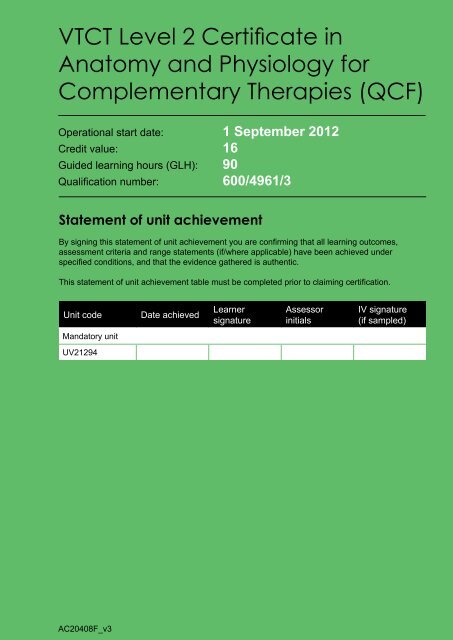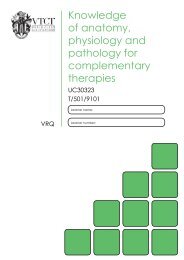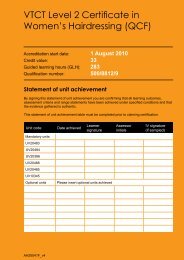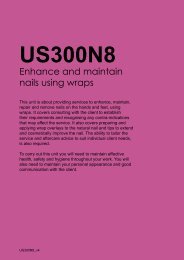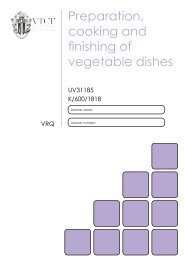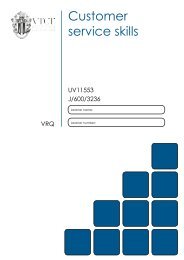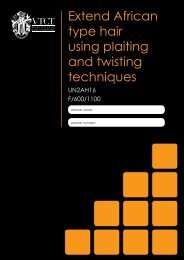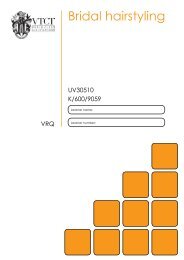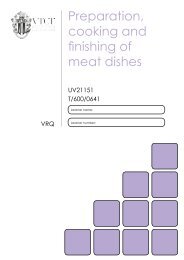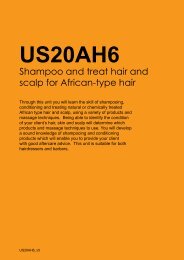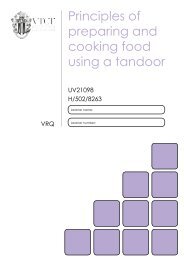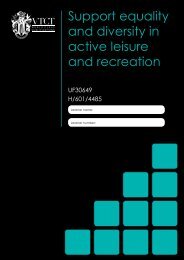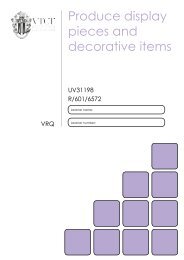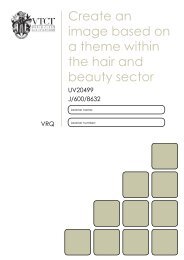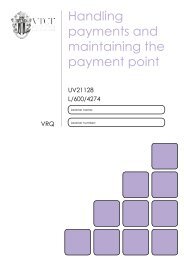VTCT Level 2 Certificate in Anatomy and Physiology for ...
VTCT Level 2 Certificate in Anatomy and Physiology for ...
VTCT Level 2 Certificate in Anatomy and Physiology for ...
Create successful ePaper yourself
Turn your PDF publications into a flip-book with our unique Google optimized e-Paper software.
<strong>VTCT</strong> <strong>Level</strong> 2 <strong>Certificate</strong> <strong>in</strong><br />
<strong>Anatomy</strong> <strong>and</strong> <strong>Physiology</strong> <strong>for</strong><br />
Complementary Therapies (QCF)<br />
Operational start date: 1 September 2012<br />
Credit value: 16<br />
Guided learn<strong>in</strong>g hours (GLH): 90<br />
Qualification number: 600/4961/3<br />
Statement of unit achievement<br />
By sign<strong>in</strong>g this statement of unit achievement you are confirm<strong>in</strong>g that all learn<strong>in</strong>g outcomes,<br />
assessment criteria <strong>and</strong> range statements (if/where applicable) have been achieved under<br />
specified conditions, <strong>and</strong> that the evidence gathered is authentic.<br />
This statement of unit achievement table must be completed prior to claim<strong>in</strong>g certification.<br />
Unit code Date achieved<br />
M<strong>and</strong>atory unit<br />
UV21294<br />
AC20408F_v3<br />
Learner<br />
signature<br />
Assessor<br />
<strong>in</strong>itials<br />
IV signature<br />
(if sampled)
2<br />
The qualification<br />
Introduction National Occupational St<strong>and</strong>ards (NOS)<br />
The <strong>VTCT</strong> <strong>Level</strong> 2 <strong>Certificate</strong> <strong>in</strong> <strong>Anatomy</strong> <strong>and</strong><br />
<strong>Physiology</strong> <strong>for</strong> Complementary Therapies<br />
(QCF) is knowledge-based qualification that will<br />
provide you with a sound plat<strong>for</strong>m <strong>for</strong> a career <strong>in</strong><br />
complementary therapies.<br />
This qualification will develop your knowledge<br />
<strong>and</strong> underst<strong>and</strong><strong>in</strong>g of the organisation of<br />
the body, <strong>and</strong> the structure, function <strong>and</strong><br />
pathologies of the sk<strong>in</strong>, hair <strong>and</strong> nails.<br />
You will also learn about the structure, function<br />
<strong>and</strong> pathologies of the various body systems<br />
<strong>in</strong>clud<strong>in</strong>g the skeletal, muscular, nervous,<br />
endocr<strong>in</strong>e, respiratory, cardiovascular,<br />
lymphatic, digestive, ur<strong>in</strong>ary <strong>and</strong> reproductive<br />
systems.<br />
Units <strong>in</strong> this qualification have been mapped<br />
to the relevant NOS (where applicable). This<br />
qualification is accredited on the Qualifications<br />
<strong>and</strong> Credit Framework (QCF).<br />
This qualification is approved <strong>and</strong> supported<br />
by Skills <strong>for</strong> Health, the sector skills council <strong>for</strong><br />
health.<br />
Prerequisites<br />
There are no <strong>for</strong>mal prerequisite qualifications<br />
that you must have prior to undertak<strong>in</strong>g this<br />
qualification.<br />
Your centre will have ensured that you have<br />
the required knowledge, underst<strong>and</strong><strong>in</strong>g <strong>and</strong><br />
skills to enrol <strong>and</strong> successfully achieve this<br />
qualification.
Progression<br />
On completion of this qualification you may<br />
choose to undertake further study; qualifications<br />
you could progress to <strong>in</strong>clude:<br />
• <strong>VTCT</strong> <strong>Level</strong> 2 Diploma <strong>in</strong> Complementary<br />
Therapies (QCF)<br />
• <strong>VTCT</strong> <strong>Level</strong> 3 Award <strong>in</strong> Healthy Eat<strong>in</strong>g <strong>and</strong><br />
Wellbe<strong>in</strong>g <strong>for</strong> the Complementary Therapy<br />
Client (QCF)<br />
• <strong>VTCT</strong> <strong>Level</strong> 3 Diploma <strong>in</strong> Complementary<br />
Therapies (QCF)<br />
• <strong>VTCT</strong> <strong>Level</strong> 3 Diploma <strong>in</strong> Aromatherapy<br />
(QCF)<br />
• <strong>VTCT</strong> <strong>Level</strong> 3 Diploma <strong>in</strong> Reflexology (QCF)<br />
• <strong>VTCT</strong> <strong>Level</strong> 3 Diploma <strong>in</strong> Massage (QCF)<br />
• <strong>VTCT</strong> <strong>Level</strong> 3 <strong>Certificate</strong> <strong>in</strong> <strong>Anatomy</strong>,<br />
<strong>Physiology</strong> <strong>and</strong> Pathology <strong>for</strong><br />
Complementary Therapies (QCF)<br />
3
4<br />
Qualification structure<br />
Total credits required - 16<br />
All m<strong>and</strong>atory units must be completed.<br />
M<strong>and</strong>atory unit - 16 credits<br />
<strong>VTCT</strong> unit<br />
code<br />
Ofqual unit<br />
reference<br />
UV21294 M/503/7628<br />
Unit title Credit value GLH<br />
Knowledge of anatomy <strong>and</strong> physiology <strong>for</strong><br />
complementary therapies<br />
16 90
Guidance on assessment<br />
This book conta<strong>in</strong>s the m<strong>and</strong>atory units that make up this qualification. Optional units will be<br />
provided <strong>in</strong> additional booklets (if applicable). Where <strong>in</strong>dicated, <strong>VTCT</strong> will provide assessment<br />
materials. Assessments may be <strong>in</strong>ternal or external. The method of assessment is <strong>in</strong>dicated <strong>in</strong><br />
each unit.<br />
Internal assessment<br />
(any requirements will be shown <strong>in</strong> the unit)<br />
Assessment is set, marked <strong>and</strong> <strong>in</strong>ternally<br />
verified by the centre to clearly demonstrate<br />
achievement of the learn<strong>in</strong>g outcomes.<br />
Assessment is sampled by <strong>VTCT</strong> external<br />
verifiers.<br />
External assessment<br />
(any requirements will be shown <strong>in</strong> the unit)<br />
Externally assessed question papers<br />
completed electronically will be set <strong>and</strong> marked<br />
by <strong>VTCT</strong>.<br />
Externally assessed hard-copy question papers<br />
will be set by <strong>VTCT</strong>, marked by centre staff <strong>and</strong><br />
sampled by <strong>VTCT</strong> external verifiers.<br />
Assessment expla<strong>in</strong>ed<br />
<strong>VTCT</strong> qualifications are assessed <strong>and</strong> verified<br />
by centre staff. Work will be set to improve your<br />
practical skills, knowledge <strong>and</strong> underst<strong>and</strong><strong>in</strong>g.<br />
For practical elements, you will be observed<br />
by your assessor. All your work must be<br />
collected <strong>in</strong> a portfolio of evidence <strong>and</strong> crossreferenced<br />
to requirements listed <strong>in</strong> this record<br />
of assessment book.<br />
Your centre will have an <strong>in</strong>ternal verifier whose<br />
role is to check that your assessment <strong>and</strong><br />
evidence is valid <strong>and</strong> reliable <strong>and</strong> meets <strong>VTCT</strong><br />
<strong>and</strong> regulatory requirements.<br />
An external verifier, appo<strong>in</strong>ted by <strong>VTCT</strong>, will<br />
visit your centre to sample <strong>and</strong> quality-check<br />
assessments, the <strong>in</strong>ternal verification process<br />
<strong>and</strong> the evidence gathered. You may be<br />
asked to attend on a different day from usual if<br />
requested by the external verifier.<br />
This record of assessment book is your<br />
property <strong>and</strong> must be <strong>in</strong> your possession when<br />
you are be<strong>in</strong>g assessed or verified. It must be<br />
kept safe. In some cases your centre will be<br />
required to keep it <strong>in</strong> a secure place. You <strong>and</strong><br />
your course assessor will together complete<br />
this book to show achievement of all learn<strong>in</strong>g<br />
outcomes, assessment criteria <strong>and</strong> ranges.<br />
5
6<br />
Creat<strong>in</strong>g a portfolio of evidence<br />
As part of this qualification you are required to<br />
produce a portfolio of evidence. A portfolio will<br />
confirm the knowledge, underst<strong>and</strong><strong>in</strong>g <strong>and</strong> skills<br />
that you have learnt. It may be <strong>in</strong> electronic or<br />
paper <strong>for</strong>mat.<br />
Your assessor will provide guidance on how to<br />
prepare the portfolio of evidence <strong>and</strong> how to<br />
show practical achievement <strong>and</strong> underst<strong>and</strong><strong>in</strong>g<br />
of the knowledge required to successfully<br />
complete this qualification. It is this booklet<br />
along with the portfolio of evidence that will<br />
serve as the prime source of evidence <strong>for</strong> this<br />
qualification.<br />
Evidence <strong>in</strong> the portfolio may take the follow<strong>in</strong>g<br />
<strong>for</strong>ms:<br />
• Observed work<br />
• Witness statements<br />
• Audio-visual media<br />
• Evidence of prior learn<strong>in</strong>g or atta<strong>in</strong>ment<br />
• Written questions<br />
• Oral questions<br />
• Assignments<br />
• Case studies<br />
All evidence should be documented <strong>in</strong> the<br />
portfolio <strong>and</strong> cross-referenced to unit outcomes.<br />
Construct<strong>in</strong>g the portfolio of evidence should not<br />
be left to the end of the course.<br />
Many frequently asked questions <strong>and</strong> other<br />
useful <strong>in</strong><strong>for</strong>mation are detailed <strong>in</strong> the <strong>VTCT</strong><br />
C<strong>and</strong>idate’s H<strong>and</strong>book, which is available on<br />
the <strong>VTCT</strong> website at www.vtct.org.uk/students.<br />
Other questions should be addressed to the<br />
tutor, lecturer or assessor.<br />
Case studies<br />
There is no case study requirement <strong>for</strong> this<br />
qualification.
Unit assessment methods<br />
This section provides an overview of the assessment methods that make up each unit <strong>in</strong> this<br />
qualification. Detailed <strong>in</strong><strong>for</strong>mation on assessment is provided <strong>in</strong> each unit.<br />
M<strong>and</strong>atory unit<br />
<strong>VTCT</strong> unit<br />
code<br />
UV21294<br />
Unit title<br />
Knowledge of anatomy <strong>and</strong><br />
physiology <strong>for</strong> complementary<br />
therapies<br />
External Internal<br />
Question<br />
paper(s)<br />
Observation(s)<br />
Portfolio of<br />
Evidence<br />
2 û <br />
7
8<br />
Unit glossary<br />
<strong>VTCT</strong> product<br />
code<br />
Description<br />
All units are allocated a unique <strong>VTCT</strong> product code <strong>for</strong> identification purposes.<br />
This code should be quoted <strong>in</strong> all queries <strong>and</strong> correspondence to <strong>VTCT</strong>.<br />
Unit title The title clearly <strong>in</strong>dicates the focus of the unit.<br />
National<br />
Occupational<br />
St<strong>and</strong>ards<br />
(NOS)<br />
<strong>Level</strong><br />
Credit value<br />
Guided<br />
learn<strong>in</strong>g hours<br />
(GLH)<br />
Observations<br />
Learn<strong>in</strong>g<br />
outcomes<br />
Evidence<br />
requirements<br />
Observation<br />
outcome<br />
Knowledge<br />
outcome<br />
Assessment<br />
criteria<br />
Range<br />
NOS describe the skills, knowledge <strong>and</strong> underst<strong>and</strong><strong>in</strong>g needed to undertake a<br />
particular task or job to a nationally recognised level of competence.<br />
<strong>Level</strong> is an <strong>in</strong>dication of the dem<strong>and</strong> of the learn<strong>in</strong>g experience; the depth<br />
<strong>and</strong>/or complexity of achievement <strong>and</strong> <strong>in</strong>dependence <strong>in</strong> achiev<strong>in</strong>g the<br />
learn<strong>in</strong>g outcomes. There are 9 levels of achievement with<strong>in</strong> the Qualifications<br />
<strong>and</strong> Credit Framework (QCF).<br />
This is the number of credits awarded upon successful achievement of all unit<br />
outcomes. Credit is a numerical value that represents a means of recognis<strong>in</strong>g,<br />
measur<strong>in</strong>g, valu<strong>in</strong>g <strong>and</strong> compar<strong>in</strong>g achievement.<br />
The number of hours of teacher-supervised or directed study time required to<br />
teach a qualification or unit of a qualification.<br />
This <strong>in</strong>dicates the m<strong>in</strong>imum number of competent observations, per outcome,<br />
required to achieve the unit.<br />
The learn<strong>in</strong>g outcomes are the most important component of the unit; they set<br />
out what is expected <strong>in</strong> terms of know<strong>in</strong>g, underst<strong>and</strong><strong>in</strong>g <strong>and</strong> practical<br />
ability as a result of the learn<strong>in</strong>g process. Learn<strong>in</strong>g outcomes are the results<br />
of learn<strong>in</strong>g.<br />
This section provides guidel<strong>in</strong>es on how evidence must be gathered.<br />
An observation outcome details the tasks that must be practically<br />
demonstrated to achieve the unit.<br />
A knowledge outcome details the theoretical requirements of a unit that must<br />
be evidenced through oral question<strong>in</strong>g, a m<strong>and</strong>atory written question paper, a<br />
portfolio of evidence or other <strong>for</strong>ms of evidence.<br />
Assessment criteria set out what is required, <strong>in</strong> terms of achievement, to meet<br />
a learn<strong>in</strong>g outcome. The assessment criteria <strong>and</strong> learn<strong>in</strong>g outcomes are the<br />
components that <strong>in</strong><strong>for</strong>m the learn<strong>in</strong>g <strong>and</strong> assessment that should take place.<br />
Assessment criteria def<strong>in</strong>e the st<strong>and</strong>ard expected to meet learn<strong>in</strong>g outcomes.<br />
The range <strong>in</strong>dicates what must be covered. Ranges must be practically<br />
demonstrated <strong>in</strong> parallel with the unit’s observation outcomes.
UV21294<br />
Knowledge of anatomy <strong>and</strong><br />
physiology <strong>for</strong> complementary<br />
therapies<br />
The aim of this unit is to develop your knowledge <strong>and</strong><br />
underst<strong>and</strong><strong>in</strong>g of the relevant anatomy <strong>and</strong> physiology that<br />
underp<strong>in</strong>s complementary therapies.<br />
UV21294_v13
<strong>Level</strong><br />
Credit value<br />
GLH<br />
2<br />
16<br />
90<br />
Observation(s)<br />
0<br />
External paper(s)<br />
2
Knowledge of anatomy <strong>and</strong><br />
physiology <strong>for</strong> complementary<br />
therapies<br />
Learn<strong>in</strong>g outcomes Evidence requirements<br />
On completion of this unit you will:<br />
1. Know the organisation of the body<br />
2. Know the structure, function <strong>and</strong><br />
pathologies of the sk<strong>in</strong>, hair <strong>and</strong> nail<br />
3. Know the structure, function <strong>and</strong><br />
pathologies of the skeletal system<br />
4. Know the structure, function <strong>and</strong><br />
pathologies of the muscular system<br />
5. Know the structure, function <strong>and</strong><br />
pathologies of the nervous system<br />
6. Know the structure, function <strong>and</strong><br />
pathologies of the endocr<strong>in</strong>e system<br />
7. Know the structure, function <strong>and</strong><br />
pathologies of the respiratory system<br />
8. Know the structure, function <strong>and</strong><br />
pathologies of the cardiovascular system<br />
9. Know the structure, function <strong>and</strong><br />
pathologies of the lymphatic system<br />
10. Know the structure, function <strong>and</strong><br />
pathologies of the other systems of the body<br />
1. Knowledge outcomes<br />
There must be evidence that you possess<br />
all the knowledge <strong>and</strong> underst<strong>and</strong><strong>in</strong>g<br />
listed <strong>in</strong> the Knowledge section of this<br />
unit. In most cases this can be done<br />
by professional discussion <strong>and</strong>/or oral<br />
question<strong>in</strong>g. Other methods, such as<br />
projects, assignments <strong>and</strong>/or reflective<br />
accounts may also be used.<br />
A m<strong>in</strong>imum of two pathologies<br />
(disorders/diseases) <strong>for</strong> each body<br />
system must be evidenced <strong>in</strong> your<br />
portfolio.<br />
2. Tutor/Assessor guidance<br />
You will be guided by your tutor/assessor<br />
on how to achieve learn<strong>in</strong>g outcomes <strong>in</strong> this<br />
unit. All outcomes must be achieved.<br />
3. External paper<br />
Knowledge <strong>and</strong> underst<strong>and</strong><strong>in</strong>g <strong>in</strong> this unit<br />
will be assessed by an external paper.<br />
The criteria that make up this paper are<br />
highlighted <strong>in</strong> white throughout this unit.<br />
There are two external papers that must<br />
be achieved.<br />
The external papers assess anatomy <strong>and</strong><br />
physiology only, pathology (disorders/<br />
diseases) is not assessed by this method.<br />
UV21294<br />
11
12<br />
Develop<strong>in</strong>g knowledge<br />
Achiev<strong>in</strong>g knowledge outcomes<br />
You will be guided by your tutor <strong>and</strong> assessor<br />
on the evidence that needs to be produced.<br />
Your knowledge <strong>and</strong> underst<strong>and</strong><strong>in</strong>g will be<br />
assessed us<strong>in</strong>g the assessment methods listed<br />
below*:<br />
• Projects<br />
• Observed work<br />
• Witness statements<br />
• Audio-visual media<br />
• Evidence of prior learn<strong>in</strong>g or atta<strong>in</strong>ment<br />
• Written questions<br />
• Oral questions<br />
• Assignments<br />
• Case studies<br />
• Professional discussion<br />
*This is not an exhaustive list.<br />
Achiev<strong>in</strong>g the external paper<br />
The external paper will test your knowledge of the criteria highlighted <strong>in</strong> white. A pass mark of<br />
70% must be achieved. Criteria not achieved will be identified to your tutor/assessor. You will then<br />
be orally questioned or asked to produce other <strong>for</strong>ms of evidence as all unit criteria must<br />
be achieved.<br />
Your assessor will complete the follow<strong>in</strong>g table when the 70% pass mark has been achieved.<br />
Paper Date achieved Assessor <strong>in</strong>itials<br />
1 of 2<br />
2 of 2<br />
UV21294
Knowledge<br />
Learn<strong>in</strong>g outcome 1<br />
Know the organisation of the body<br />
You can:<br />
a. State the anatomical regions of the body<br />
b. Describe the directional terms of the body<br />
c. Describe the basic chemical organisation of the body<br />
d. Describe the basic structure of a cell<br />
e. State the major tissue types <strong>and</strong> their location<br />
* Assessor <strong>in</strong>itials to be <strong>in</strong>serted if orally questioned.<br />
Requirements highlighted <strong>in</strong> white are assessed <strong>in</strong> the external paper.<br />
Portfolio reference /<br />
Assessor <strong>in</strong>itials*<br />
UV21294 13
14<br />
Learn<strong>in</strong>g outcome 2<br />
Know the structure, function <strong>and</strong> pathologies of the sk<strong>in</strong>, hair<br />
<strong>and</strong> nail<br />
You can:<br />
a. Describe the structure <strong>and</strong> functions of the sk<strong>in</strong><br />
b. State the sk<strong>in</strong> types <strong>and</strong> factors that affect the sk<strong>in</strong><br />
c. Describe the structure <strong>and</strong> function of the hair<br />
d. Describe the structure <strong>and</strong> function of the nail<br />
e. Describe diseases <strong>and</strong> disorders of the sk<strong>in</strong>, hair <strong>and</strong> nails<br />
* Assessor <strong>in</strong>itials to be <strong>in</strong>serted if orally questioned.<br />
Requirements highlighted <strong>in</strong> white are assessed <strong>in</strong> the external paper.<br />
Portfolio reference /<br />
Assessor <strong>in</strong>itials*<br />
A m<strong>in</strong>imum of two pathologies <strong>for</strong> each body system must be evidenced <strong>in</strong> your portfolio.<br />
UV21294
Learn<strong>in</strong>g outcome 3<br />
Know the structure, function <strong>and</strong> pathologies of the skeletal<br />
system<br />
You can:<br />
a. Describe the structure <strong>and</strong> functions of the skeleton<br />
b. State the bones of the head, neck, upper limbs, h<strong>and</strong>s, lower limbs<br />
<strong>and</strong> feet<br />
c. Identify the arches of the foot<br />
d. State the types of jo<strong>in</strong>t<br />
e. State the range of jo<strong>in</strong>t movements<br />
f. Describe the diseases <strong>and</strong> disorders of the skeletal system<br />
* Assessor <strong>in</strong>itials to be <strong>in</strong>serted if orally questioned.<br />
Requirements highlighted <strong>in</strong> white are assessed <strong>in</strong> the external paper.<br />
Portfolio reference /<br />
Assessor <strong>in</strong>itials*<br />
A m<strong>in</strong>imum of two pathologies <strong>for</strong> each body system must be evidenced <strong>in</strong> your portfolio.<br />
UV21294 15
16<br />
Learn<strong>in</strong>g outcome 4<br />
Know the structure, function <strong>and</strong> pathologies of the muscular<br />
system<br />
You can:<br />
a. Identify the location of the muscles of the head, face, neck,<br />
shoulders, arms, h<strong>and</strong>s, lower leg <strong>and</strong> foot<br />
b. Describe the actions of the muscles of the head, face, neck,<br />
shoulders, arms, h<strong>and</strong>s, lower leg <strong>and</strong> foot<br />
c. State the different types of muscle contraction<br />
d. Describe the diseases <strong>and</strong> disorders of the muscular system<br />
* Assessor <strong>in</strong>itials to be <strong>in</strong>serted if orally questioned.<br />
Requirements highlighted <strong>in</strong> white are assessed <strong>in</strong> the external paper.<br />
Portfolio reference /<br />
Assessor <strong>in</strong>itials*<br />
A m<strong>in</strong>imum of two pathologies <strong>for</strong> each body system must be evidenced <strong>in</strong> your portfolio.<br />
UV21294
Learn<strong>in</strong>g outcome 5<br />
Know the structure, function <strong>and</strong> pathologies of the nervous<br />
system<br />
You can:<br />
a. State the structure <strong>and</strong> function of the nervous system<br />
b. Describe the diseases <strong>and</strong> disorders of the nervous system<br />
* Assessor <strong>in</strong>itials to be <strong>in</strong>serted if orally questioned.<br />
Requirements highlighted <strong>in</strong> white are assessed <strong>in</strong> the external paper.<br />
Portfolio reference /<br />
Assessor <strong>in</strong>itials*<br />
A m<strong>in</strong>imum of two pathologies <strong>for</strong> each body system must be evidenced <strong>in</strong> your portfolio.<br />
UV21294 17
18<br />
Learn<strong>in</strong>g outcome 6<br />
Know the structure, function <strong>and</strong> pathologies of the endocr<strong>in</strong>e<br />
system<br />
You can:<br />
a. State the functions of the endocr<strong>in</strong>e system<br />
b. State the position <strong>and</strong> function of the endocr<strong>in</strong>e gl<strong>and</strong>s<br />
c. Describe the diseases <strong>and</strong> disorders of the endocr<strong>in</strong>e system<br />
* Assessor <strong>in</strong>itials to be <strong>in</strong>serted if orally questioned.<br />
Requirements highlighted <strong>in</strong> white are assessed <strong>in</strong> the external paper.<br />
Portfolio reference /<br />
Assessor <strong>in</strong>itials*<br />
A m<strong>in</strong>imum of two pathologies <strong>for</strong> each body system must be evidenced <strong>in</strong> your portfolio.<br />
UV21294
Learn<strong>in</strong>g outcome 7<br />
Know the structure, function <strong>and</strong> pathologies of the respiratory<br />
system<br />
You can:<br />
a. State the structure <strong>and</strong> function of the respiratory system<br />
b. State the difference between <strong>in</strong>ternal <strong>and</strong> external respiration<br />
c. Describe the diseases <strong>and</strong> disorders of the respiratory system<br />
* Assessor <strong>in</strong>itials to be <strong>in</strong>serted if orally questioned.<br />
Requirements highlighted <strong>in</strong> white are assessed <strong>in</strong> the external paper.<br />
Portfolio reference /<br />
Assessor <strong>in</strong>itials*<br />
A m<strong>in</strong>imum of two pathologies <strong>for</strong> each body system must be evidenced <strong>in</strong> your portfolio.<br />
UV21294 19
20<br />
Learn<strong>in</strong>g outcome 8<br />
Know the structure, function <strong>and</strong> pathologies of the<br />
cardiovascular system<br />
You can:<br />
a. State the structure <strong>and</strong> functions of the cardiovascular system<br />
b. State the composition <strong>and</strong> functions of the blood<br />
c. State the primary vessels <strong>in</strong> the head, face, neck, h<strong>and</strong>, wrist,<br />
<strong>for</strong>earm, foot, ankle <strong>and</strong> lower leg<br />
d. Describe the diseases <strong>and</strong> disorders of the cardiovascular system<br />
* Assessor <strong>in</strong>itials to be <strong>in</strong>serted if orally questioned.<br />
Requirements highlighted <strong>in</strong> white are assessed <strong>in</strong> the external paper.<br />
Portfolio reference /<br />
Assessor <strong>in</strong>itials*<br />
A m<strong>in</strong>imum of two pathologies <strong>for</strong> each body system must be evidenced <strong>in</strong> your portfolio.<br />
UV21294
Learn<strong>in</strong>g outcome 9<br />
Know the structure, function <strong>and</strong> pathologies of the lymphatic<br />
system<br />
You can:<br />
a. State the function of the lymphatic system<br />
b. State the structure of the lymphatic system<br />
c. State the location of the major lymphatic nodes <strong>in</strong> the head, face,<br />
neck, h<strong>and</strong>, wrist, <strong>for</strong>earm, foot, ankle <strong>and</strong> lower leg<br />
d. Describe the diseases <strong>and</strong> disorders of the lymphatic system<br />
* Assessor <strong>in</strong>itials to be <strong>in</strong>serted if orally questioned.<br />
Requirements highlighted <strong>in</strong> white are assessed <strong>in</strong> the external paper.<br />
Portfolio reference /<br />
Assessor <strong>in</strong>itials*<br />
A m<strong>in</strong>imum of two pathologies <strong>for</strong> each body system must be evidenced <strong>in</strong> your portfolio.<br />
UV21294 21
22<br />
Learn<strong>in</strong>g outcome 10<br />
Know the structure, function <strong>and</strong> pathologies of the other<br />
systems of the body<br />
You can:<br />
a. State the structure <strong>and</strong> function of the digestive system<br />
b. Describe the diseases <strong>and</strong> disorders of the digestive system<br />
c. State the structure <strong>and</strong> function of the ur<strong>in</strong>ary system<br />
d. Describe the diseases <strong>and</strong> disorders of the ur<strong>in</strong>ary system<br />
e. State the structure <strong>and</strong> function of the reproductive system<br />
f. Describe the diseases <strong>and</strong> disorders of the reproductive system<br />
* Assessor <strong>in</strong>itials to be <strong>in</strong>serted if orally questioned.<br />
Requirements highlighted <strong>in</strong> white are assessed <strong>in</strong> the external paper.<br />
Portfolio reference /<br />
Assessor <strong>in</strong>itials*<br />
A m<strong>in</strong>imum of two pathologies <strong>for</strong> each body system must be evidenced <strong>in</strong> your portfolio.<br />
UV21294
Unit content<br />
This section provides guidance on the recommended knowledge <strong>and</strong> skills required to enable you<br />
to achieve each of the learn<strong>in</strong>g outcomes <strong>in</strong> this unit. Your tutor/assessor will ensure you have the<br />
opportunity to cover all of the unit content.<br />
Learn<strong>in</strong>g outcome 1: Know the organisation of the body<br />
Anatomical regions of the body:<br />
Def<strong>in</strong>itions <strong>and</strong> locations of regions<br />
(cephalic, frontal, cervical, cranial,<br />
occipital, thoracic, brachial, cubital, carpal,<br />
palmar, digital, popliteal, patellar, tarsal,<br />
plantar, cutaneous).<br />
Directional terms: Def<strong>in</strong>itions <strong>and</strong><br />
examples of terms (superior, <strong>in</strong>ferior,<br />
medial, lateral, superficial, deep, anterior,<br />
posterior, proximal, <strong>and</strong> distal).<br />
Basic chemical organisation of the<br />
body: Simple chemicals (e.g. oxygen,<br />
carbon dioxide), nutrient chemicals (e.g.<br />
carbohydrates, fats (lipids), prote<strong>in</strong>s,<br />
vitam<strong>in</strong>s, m<strong>in</strong>erals, fibre, water), complex<br />
chemicals (e.g. ATP, DNA, body fluids).<br />
Basic structure of a cell: Structural<br />
components (cell membrane, nucleus,<br />
nucleolus, cytoplasm, vacuoles, vesicles,<br />
centrosome, organelles, Golgi, lysosome,<br />
ribosome, mitochondria, endoplasmic<br />
reticulum).<br />
Major tissue types <strong>and</strong> location:<br />
Epithelial tissue (protective, secretory),<br />
muscular tissue (striated, non-striated,<br />
cardiac), nervous tissue, connective tissue<br />
(areolar, adipose, cartilage, bone, blood,<br />
lymph).<br />
UV21294 23
24<br />
Learn<strong>in</strong>g outcome 2: Know the structure, function <strong>and</strong> pathologies of the<br />
sk<strong>in</strong>, hair <strong>and</strong> nail<br />
Structure of sk<strong>in</strong>: Epidermis layer<br />
structure (stratum corneum/horny, stratum<br />
lucidum/clear, stratum granulosum/<br />
granular, stratum sp<strong>in</strong>osum/prickle,<br />
stratum germanativum/basal), dermis layer<br />
structure (papillary, reticular, subcutaneous,<br />
blood capillary, lymphatic capillary<br />
network, hair, sebaceous gl<strong>and</strong>, sweat<br />
gl<strong>and</strong>s, sensory <strong>and</strong> motor nerve end<strong>in</strong>gs,<br />
collagen), subcutaneous layer structure<br />
(adipose).<br />
Functions of the sk<strong>in</strong>: Secretion,<br />
heat regulation, absorption, protection,<br />
excretion, sensation, vitam<strong>in</strong> D production.<br />
Growth <strong>and</strong> repair cycle of sk<strong>in</strong>: Cell<br />
<strong>for</strong>mation, kerat<strong>in</strong>isation, desquamation.<br />
An awareness of diseases <strong>and</strong><br />
disorders of the sk<strong>in</strong>: Causes, signs <strong>and</strong><br />
symptoms, <strong>in</strong>festations (scabies, mites,<br />
head lice, pediculosis pubis, pediculosis<br />
corporis), bacterial <strong>in</strong>fections (impetigo,<br />
conjunctivitis, acne vulgaris, acne rosacea,<br />
boils, folliculitis), viral <strong>in</strong>fections (herpes<br />
simplex, herpes zoster, verrucae or warts),<br />
fungal diseases (t<strong>in</strong>ea corporis, t<strong>in</strong>ea<br />
capitis, t<strong>in</strong>ea pedis), allergies (dermatitis,<br />
eczema, urticaria), pigmentation disorders<br />
(vitiligo, alb<strong>in</strong>ism, chloasma, ephelides,<br />
lentigo, naevae, leucoderma, erythema),<br />
general disorders (e.g. sensitive sk<strong>in</strong>,<br />
ultraviolet damage, pustules, papules), sk<strong>in</strong><br />
cancers (melanoma, carc<strong>in</strong>oma).<br />
Sk<strong>in</strong> types <strong>and</strong> factors affect<strong>in</strong>g<br />
the sk<strong>in</strong>: Def<strong>in</strong>ition <strong>and</strong> appearance<br />
of sk<strong>in</strong> types (mature, young, dry, oily,<br />
comb<strong>in</strong>ation, sensitive, balanced), factors<br />
affect<strong>in</strong>g the sk<strong>in</strong> (age, diet, smok<strong>in</strong>g,<br />
alcohol, ultraviolet, stress, climate).<br />
UV21294<br />
Hair function, structure, growth cycle<br />
<strong>and</strong> role: Hair types <strong>and</strong> functions<br />
(lanugo, vellus, term<strong>in</strong>al), hair structure<br />
<strong>and</strong> functions (cuticle, cortex, medulla,<br />
dermal papilla), hair growth cycle (anagen,<br />
catagen, telogen), factors affect<strong>in</strong>g hair<br />
growth.<br />
Diseases <strong>and</strong> disorders of the hair:<br />
Hirsuitism, alopecia, hair shaft disorders.<br />
Nail unit, function, diseases <strong>and</strong><br />
disorders, <strong>and</strong> growth cycle: Def<strong>in</strong>ition<br />
<strong>and</strong> location of nail structures (nail bed,<br />
hyponychium, eponychium, perionychium,<br />
mantle, lateral nail fold, nail grooves,<br />
matrix, lunula, cuticle, nail plate, free<br />
edge), function of nails (protection, manual<br />
dexterity), nail growth cycle (nail <strong>for</strong>mation<br />
<strong>in</strong> matrix, growth rates), factors affect<strong>in</strong>g<br />
nail growth, causes <strong>and</strong> appearance of<br />
nail diseases <strong>and</strong> disorders (leukonychia,<br />
hang nail, paronychia, onychorrhexis,<br />
onycholysis, transverse ridges, vertical<br />
ridges, t<strong>in</strong>ea unguium, pitt<strong>in</strong>g).
Learn<strong>in</strong>g outcome 3: Know the structure, function <strong>and</strong> pathologies of the<br />
skeletal system<br />
Functions of the skeleton: Shape <strong>and</strong><br />
support, muscle attachment, movement<br />
<strong>and</strong> leverage, production of red blood cells,<br />
storage of calcium, protection.<br />
Bones <strong>and</strong> structure of the skeleton:<br />
Structure <strong>and</strong> function of different types of<br />
bones (compact, cancellous, long, short,<br />
flat, irregular, sesamoid), head (frontal,<br />
parietal, temporal, occipital, sphenoid,<br />
ethmoid, nasal, zygomatic, maxillae,<br />
m<strong>and</strong>ible), neck (cervical vertebrae, atlas,<br />
axis), sp<strong>in</strong>e (thoracic vertebrae, lumbar<br />
vertebrae, sacral vertebrae, coccygeal<br />
vertebrae, <strong>in</strong>tervertebral discs), torso (ribs,<br />
sternum, clavicle, scapula, pelvic girdle),<br />
upper limbs (humerus, radius, ulna), h<strong>and</strong>s<br />
(carpals, metacarpals, phalanges), lower<br />
limbs (femur, patella, tibia, fibula), feet<br />
(tarsals, metatarsals, phalanges).<br />
Arches of the foot: Structure <strong>and</strong><br />
locations (medial longitud<strong>in</strong>al, lateral<br />
longitud<strong>in</strong>al, anterior transverse, posterior<br />
transverse).<br />
Types of jo<strong>in</strong>t: Fixed, slightly moveable,<br />
freely moveable (ball <strong>and</strong> socket, h<strong>in</strong>ge,<br />
pivot, glid<strong>in</strong>g, saddle, ellipsoid), structure<br />
<strong>and</strong> example locations.<br />
Range of jo<strong>in</strong>t movement: Def<strong>in</strong>itions<br />
of movements (flexion, extension,<br />
circumduction, rotation, adduction,<br />
abduction, pronation, sup<strong>in</strong>ation,<br />
dorsiflexion, plantar flexion, eversion,<br />
<strong>in</strong>version), range of jo<strong>in</strong>t movement<br />
examples.<br />
Pathologies: Causes, signs <strong>and</strong><br />
symptoms (osteoporosis, osteoarthritis,<br />
rheumatoid arthritis, bursitis, gout, hallux<br />
valgus, bunions).<br />
UV21294 25
26<br />
Learn<strong>in</strong>g outcome 4: Know the structure, function <strong>and</strong> pathologies of the<br />
muscular system<br />
Location of muscles:<br />
Head <strong>and</strong> face – frontalis, occipitalis,<br />
temporalis, procerus, corrugator, orbicularis<br />
oculi, risorius, bucc<strong>in</strong>ator, mentalis,<br />
masseter, platysma.<br />
Neck – sternocleidomastoid, zygomaticus,<br />
orbicularis oris.<br />
Shoulders – deltoids, trapezius, pectoralis<br />
major.<br />
Arms <strong>and</strong> h<strong>and</strong>s – biceps, triceps,<br />
extensor, flexor.<br />
UV21294<br />
Lower leg <strong>and</strong> foot – gastrocnemius,<br />
soleus, tibialis anterior, peroneus longus,<br />
flexors, extensors.<br />
Muscle actions: Examples of muscles<br />
<strong>and</strong> associated actions (flexion, extension,<br />
circumduction, rotation, adduction,<br />
abduction, pronation, sup<strong>in</strong>ation,<br />
dorsiflexion, plantar flexion, eversion,<br />
<strong>in</strong>version).<br />
Pathologies: Causes, signs <strong>and</strong><br />
symptoms (cramp, repetitive stra<strong>in</strong> <strong>in</strong>jury,<br />
muscle stra<strong>in</strong>).<br />
Learn<strong>in</strong>g outcome 5: Know the structure, function <strong>and</strong> pathologies of the<br />
nervous system<br />
Functions of the nervous system:<br />
Detection of stimuli, process <strong>and</strong><br />
<strong>in</strong>terpretation of stimuli, response to<br />
stimuli.<br />
Organisation of the nervous system:<br />
Structure <strong>and</strong> function (central nervous<br />
system, peripheral nervous system,<br />
somatic nervous system, autonomic<br />
nervous system, sympathetic,<br />
parasympathetic).<br />
Types of neurone: Motor (efferent),<br />
sensory (afferent), mixed nerves, neurone<br />
locations <strong>and</strong> roles.<br />
Structure of a motor neurone: Axon,<br />
dendrites, cell body, myel<strong>in</strong> sheath.<br />
Location of structures of the bra<strong>in</strong>:<br />
Men<strong>in</strong>ges, cerebrosp<strong>in</strong>al fluid, cerebrum,<br />
cerebellum, pons Varolii, medulla<br />
oblongata, thalamus, hypothalamus, bra<strong>in</strong><br />
stem.<br />
Cranial nerves: Olfactory, 5th (trigem<strong>in</strong>al),<br />
7th (facial), 11th (accessory), location <strong>and</strong><br />
function of cranial nerves.<br />
Pathologies: Causes, signs <strong>and</strong><br />
symptoms (neuritis, Bell’s palsy, epilepsy,<br />
neuralgia, migra<strong>in</strong>e, Park<strong>in</strong>son’s disease,<br />
myalgic encephalomyelitis, cerebral palsy,<br />
multiple sclerosis, sciatica, motor neurone<br />
disease).
Learn<strong>in</strong>g outcome 6: Know the structure, function <strong>and</strong> pathologies of the<br />
endocr<strong>in</strong>e system<br />
Functions of the endocr<strong>in</strong>e system:<br />
Hormone secretion, homeostasis, control of<br />
body functions.<br />
Structure of the endocr<strong>in</strong>e system:<br />
Location <strong>and</strong> role of gl<strong>and</strong>s (pituitary,<br />
thyroid gl<strong>and</strong>, parathyroid, thymus, p<strong>in</strong>eal,<br />
pancreas, adrenals, ovaries, testes).<br />
Pathologies: Causes, signs <strong>and</strong> symptoms<br />
(Addison’s syndrome, amenorrhoea,<br />
diabetes mellitus, diabetes <strong>in</strong>sipidus).<br />
Learn<strong>in</strong>g outcome 7: Know the structure, function <strong>and</strong> pathologies of the<br />
respiratory system<br />
Functions of the respiratory system:<br />
Oxygen supply, carbon dioxide removal,<br />
<strong>in</strong>ternal respiration, external respiration,<br />
gaseous exchange, composition of <strong>in</strong>haled<br />
<strong>and</strong> exhaled air.<br />
Structure of the respiratory system:<br />
Mouth, nose, nasal cavity, larynx, pharynx,<br />
epiglottis, trachea, bronchi, bronchioles,<br />
alveoli, lungs, pleura, diaphragm,<br />
<strong>in</strong>tercostal muscles.<br />
Pathologies: Causes, signs <strong>and</strong><br />
symptoms, obstructive (e.g. emphysema,<br />
bronchitis, asthma), other (e.g. pneumonia,<br />
tuberculosis, hay fever, rh<strong>in</strong>itis, whoop<strong>in</strong>g<br />
cough, s<strong>in</strong>usitis, laryngitis, pharyngitis).<br />
UV21294 27
28<br />
Learn<strong>in</strong>g outcome 8: Know the structure, function <strong>and</strong> pathologies of the<br />
cardiovascular system<br />
Functions of the cardiovascular system:<br />
Transport, heat regulation, protection,<br />
blood flow distribution.<br />
Structure of the cardiovascular system:<br />
Heart, arteries, arterioles, ve<strong>in</strong>s, venules,<br />
capillaries, blood plasma, erythrocytes,<br />
leucocytes, platelets, thrombocytes.<br />
Function of the blood: Transportation<br />
(oxygen, carbon dioxide, waste products,<br />
hormones, enzymes, blood cells, nutrients),<br />
protection (clott<strong>in</strong>g mechanism, fights<br />
<strong>in</strong>fection), regulation of body temperature.<br />
UV21294<br />
Primary vessels: Location <strong>and</strong> role, head,<br />
face <strong>and</strong> neck (common carotid artery,<br />
external carotid artery, <strong>in</strong>ternal carotid<br />
artery, external jugular ve<strong>in</strong>, <strong>in</strong>ternal jugular<br />
ve<strong>in</strong>), h<strong>and</strong>, wrist <strong>and</strong> <strong>for</strong>earm (radial <strong>and</strong><br />
ulnar arteries, basilica <strong>and</strong> cephalic ve<strong>in</strong>s),<br />
foot, ankle <strong>and</strong> lower leg (anterior tibial<br />
artery/ve<strong>in</strong>, posterior tibial artery/ve<strong>in</strong>,<br />
saphenous ve<strong>in</strong>, iliac ve<strong>in</strong>, femoral ve<strong>in</strong>).<br />
Pathologies: Causes, signs <strong>and</strong> symptoms<br />
(anaemia, aneurysm, arteriosclerosis,<br />
atherosclerosis, coronary thrombosis,<br />
deep ve<strong>in</strong> thrombosis (DVT), hypertension,<br />
hypotension, varicose ve<strong>in</strong>s, palpitations,<br />
high cholesterol).<br />
Learn<strong>in</strong>g outcome 9: Know the structure, function <strong>and</strong> pathologies of the<br />
lymphatic system<br />
Function of the lymphatic system:<br />
Transportation (excess fluid, <strong>for</strong>eign<br />
particles, fats), purification (waste <strong>and</strong><br />
tox<strong>in</strong>s), protection (antibodies <strong>for</strong> defence).<br />
Structure of the lymphatic system:<br />
Lymphocytes, lymphatic capillaries,<br />
lymphatic vessels, lymph nodes, lymphatic<br />
ducts, lymphatic tissue (e.g. tonsils,<br />
appendix).<br />
Location of the major lymphatic nodes:<br />
In the head <strong>and</strong> neck <strong>and</strong> related areas<br />
(deep <strong>and</strong> superficial cervical, m<strong>and</strong>ibular<br />
<strong>and</strong> subm<strong>and</strong>ibular, submental, anterior<br />
<strong>and</strong> posterior auricular, occipital, buccal,<br />
axillary, supratrochlear, popliteal).<br />
Pathologies: Causes, signs <strong>and</strong><br />
symptoms (cancer, fever, cellulitis,<br />
rheumatoid arthritis, oedema, Hodgk<strong>in</strong>’s<br />
disease, lymphoedema).
Learn<strong>in</strong>g outcome 10: Know the structure, function <strong>and</strong> pathologies of the<br />
other systems of the body<br />
Functions of the digestive system:<br />
Ingestion, mechanical <strong>and</strong> chemical<br />
breakdown of food, digestion, absorption of<br />
nutrients, defaecation.<br />
Structure of the digestive system:<br />
Mouth, tongue, teeth, salivary gl<strong>and</strong>s,<br />
pharynx, epiglottis, oesophagus, stomach,<br />
small <strong>in</strong>test<strong>in</strong>e, large <strong>in</strong>test<strong>in</strong>e, rectum,<br />
anus.<br />
Pathologies of the digestive system:<br />
Causes, signs <strong>and</strong> symptoms (heartburn,<br />
<strong>in</strong>digestion, irritable bowel syndrome,<br />
constipation, diarrhoea, gall stones,<br />
coeliac’s disease, ulcer).<br />
Functions of the ur<strong>in</strong>ary system:<br />
Filtration, reabsorption, secretion.<br />
Structure of the ur<strong>in</strong>ary system: Kidneys,<br />
pelvis, ureter, bladder, urethra).<br />
Pathologies of the ur<strong>in</strong>ary system:<br />
Causes, signs <strong>and</strong> symptoms (cystitis,<br />
kidney stones, bladder stones, nephritis).<br />
Functions of the reproductive system:<br />
Reproduction.<br />
Structure of the female reproductive<br />
system: Ovary, fallopian tubes, uterus,<br />
cervix, vag<strong>in</strong>a, labia, clitoris.<br />
Structure of the male reproductive<br />
system: Testes, scrotum, epididymis,<br />
sem<strong>in</strong>al vesicles, prostate, urethra, penis.<br />
Pathologies of the female reproductive<br />
system: Amenorrhoea, dysmenorrhoea,<br />
pre-menstrual syndrome, sexually<br />
transmitted diseases, polycystic ovarian<br />
syndrome.<br />
Pathologies of the male reproductive<br />
system: Sexually transmitted diseases,<br />
penile cancer, testicular cancer, prostate<br />
cancer, epididymitis.<br />
UV21294 29
30<br />
UV21294<br />
Notes<br />
Use this area <strong>for</strong> mak<strong>in</strong>g notes <strong>and</strong> draw<strong>in</strong>g diagrams


